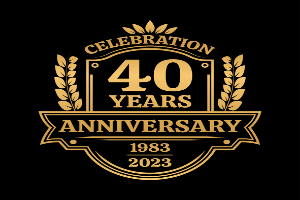
UST has been on the front lines of supporting the nonprofit sector with effective workforce solutions that reduce costs and strengthen their missions for four decades. Throughout our journey, UST has built a reputation for providing innovative solutions and excellent customer service to our 2,200+ nonprofit members—working tirelessly to help nonprofits build strong, effective workforces that support their mission-critical initiatives while also saving valuable time and money.
One of the reasons UST has been so successful over the last 40 years is our deep understanding of the nonprofit sector and the unique challenges facing nonprofit organizations, from funding constraints to the need for specialized expertise. We continue to develop services that are tailored to meet the specific needs of nonprofits, whether it’s reducing unemployment costs, maintaining compliance with state and federal legislation, or tackling day-to-day HR needs.
As we celebrate our accomplishments over the last four decades, we also recognize that our success is due largely to the overwhelming support we receive from the nonprofit sector and consider ourselves extremely fortunate to work with people who share in our passion to strengthen nonprofit communities across the country.
A word from UST’s Executive Director, Donna Groh:
As UST celebrates its 40th anniversary this year, we are very proud of how many nonprofits we have helped over that span of time. To give a little perspective, UST has successfully:
But we are not resting on our laurels. Last year, we created a subsidiary LLC that will be developing programs to support nonprofit employers whether they are members of the Trust or choose to manage their unemployment benefits on their own or through the state tax system. The programs and services we will be focused on will be those that will help nonprofit employers attract, engage, and retain a vibrant workforce. We will have more details as specific programs develop so stay tuned.
Finally, as we look to the future, I will be stepping down as the Executive Director of UST and retiring in the Fall. We recently identified (and appointed) an impressive individual who will be coming on board this Summer for which I will provide an onboarding and consultative transition over the coming months.
To all of you who have been on this journey with us, we thank you and look forward to continued partnerships.

The Coronavirus pandemic has pushed the economy into a sudden and deep recession, impacting local businesses as well as a number of large corporations. But the effects of this pandemic on the nonprofit organization has been even more substantial and unfortunately, gone unnoticed. Many citizens rely on the services nonprofits provide such as, social services, medical care and spiritual community. Tens of thousands of nonprofits are likely to close without the support of some kind of rescue package to help keep their doors open. The nonprofit sector is the nation’s third-largest private employer, with 1.3 million nonprofits employing nearly 12.5 million people—about 10 percent of the total number of people working in the private sector.
According to the John Hopkins University 2020 Nonprofit Unemployment Report, more than 1.6 million nonprofit jobs have been lost between March and May of 2020. Private education nonprofits lost an estimated 323,201 jobs, while health care lost an estimated 574,530. As we know, nonprofits come in many shapes and sizes, ranging from large organizations, like city hospitals to small mom and pop thrift shops that help support local charities. No matter the size, nonprofits have been severely impacted by the pandemic in more ways than one. Many nonprofits are unable to perform normal day-to-days tasks due to the number of shutdowns and social distancing requirements. For food pantries and free clinics, the economic disruption has caused an increase in clients in need of these services. While many think of nonprofits as running predominately on donations, roughly half of their revenue come from billing for services, a third from government contracts and grants, and only about 9 percent from individual donations.
While some foundations and charitable-giving funds have seen an increase in their donations, other nonprofits have not had the same luck due to relying on revenue-generating activities and fundraising. Making it not only difficult to keep people on the payroll but also impacting long-term viability of their organization.
Many nonprofits were eligible for federal pandemic aid under the Paycheck Protection Program, which extended potentially forgivable loans to small employers to keep workers on the payroll. But qualifying for such aid can be difficult. Give Kids the World received $1.75 million, however, organizations like the Y.M.C.A. of Metropolitan Chicago were left out because they had more than 500 employees.
The nonprofit sector has more of an impact on the overall economy than many realize—offering crucial contributions to the country’s health, education, social service, and cultural activities. Nonprofits not only make up the country’s third largest workforce but also generate the third largest payroll of any national industry while making important contributions to the tax revenue of the country’s national, state, and local governments. The devastation of this pandemic has put many individuals out of work while closing the doors of many other beloved nonprofits—putting pressure on the vital services these organizations offer their communities.

UST is deeply saddened by the series of disturbing and tragic events that have taken place over the last few weeks related to the violence and injustice toward the Black community—including George Floyd, Breonna Taylor, Ahmaud Arbery, and countless others. The resulting protests have created a long overdue flashpoint for awareness, action, and change.
UST has supported the nonprofit community for over 35 years and we are proud of the impact that each of our members have in their communities. We know that communities that have nonprofit organizations established within experience less crime, such as murder, violent crime and crimes against property. Sharkey’s work also affirms some of the tenets of community policing: that neighborhoods are vital to policing themselves, and that they can address the complex roots of violence in ways that fall beyond traditional police work. Whether it is taking back the public parks, establishing mentorship programs for youth or implementing job training and employment opportunities, these all make a difference. But. That. Is. Not. Enough.
UST does not do this work directly but we support the organizations who do in their efforts, their ideals and their fight for more social justice and equity in communities across the nation. We are fortunate to have a strong board of Trustees who are all working in their own spaces for change. We think our current Board Chair, Karen Beavor, CEO of the Georgia Center for Nonprofits has expressed our sentiments exceptionally well. View her complete message here.
UST will continue to support the work our nonprofit members do to address these issues; we will listen, and will actively look for ways to be part of the change that is so desperately needed.

September resulted in positive job growth with employers adding an additional 134,000 jobs—resulting in an average monthly gain of 201,000 over the past 12 months. These jobs were added across a variety of sectors including professional and business services, health care, transportation and warehousing.
The unemployment rate dropped by 0.2 of a percentage point to 3.7% in September, and the number of unemployed persons decreased by 270,000 to 6.0 million. Over the year, the unemployment rate and the number of unemployed persons declined by 0.5 percentage point and 795,000. The number of long-term unemployed (those jobless for 27 weeks or more) showed slight change at 1.4 million in September and accounted for 22.9 percent of the unemployed. Over the year, the number of people employed part time for economic reasons increased by 263,000 to 4.6 million
Job gains occurred in professional and business services (54,000), healthcare (26,000), transportation and warehousing (8,000), construction (+23,000), manufacturing (+18,000), and mining (6,000) while leisure and hospitality showed little change (-17,000). Prior to September, employment had shown an upward trend, however Hurricane Florence might have had an impact on the number of jobs for this industry. Employment in other major industries, including wholesale trade, retail trade information, financial activities and government, showed little to no change over the month.
In September, average hourly earnings for all employees on private nonfarm payrolls increased by 8 cents to $27.24. Over the course of the year, average hourly earnings had risen by 73 cents or 2.8 percent.
With the impact of Hurricane Florence affecting parts of the East Coast during the reference periods in September for the establishment and household surveys, the Bureau of Labor Statistics will be releasing the state estimates of employment and unemployment on October 19, 2018 at 10:00am (EDT).

U.S. employers added 223,000 nonfarm payroll jobs in May, compared with an average monthly gain of 191,000 over the prior 12 months. With the unemployment rate down to 3.8 percent—an eighteen year record low—the U.S. Bureau of Labor Statistics reported employment has continued to trend upward in multiple industries, including retail trade, health care and construction.
May marked the 92nd straight month of job growth in the U.S., with the number of unemployed persons declining to 6.1 million. Since the beginning of the year, unemployment rate has gone down by 0.5 percent, and the number of unemployed persons decreased by 772,000.
The U.S. economy added 31,000 jobs in retail trade, with an increase occurring in general merchandise stores, building materials and garden supplies. Employment in health care increased by 29,000 and construction rose by 25,000 with a continual growth of 286,000 positions over the past 12 months. Both professional and technical services have shown a gain of 23,000 jobs and has increased by 206,000 over the year. Manufacturing employment has continued to grow during the month of May with 18,000 jobs—durable goods required due to an addition of 6,000 jobs in machinery. Employment in other major industries, such as wholesale trade, information, financial activities, leisure and hospitality and government, showed little to no change over the course of the month.
In May, average hourly earnings for all employees on private nonfarm payrolls rose by 8 cents to $26.92. Over the past 12 months, average hourly earnings have increased by 2.7 percent and the average hourly earnings of private-sector production and nonsupervisory employees increased by 7 cents to $22.59 in May.
With job openings being at a two-decade high, this is good news for the many young people who have recently graduated. However, there are still many working-age people on the sidelines of the job market. Though more people have joined the workforce in the first quarter of 2018 than in the first quarter of 2017, the share of prime-age workers who are employed still hasn’t returned to where it was prior to the recession.
December marked the 87th consecutive month of job growth, adding an additional 148,000 positions during the month – bringing the total number of jobs filled in 2017 to 2.06 million. The unemployment rate remained unchanged at 4.1 percent for the third consecutive month but fell over the year by 0.74 percent, a 17-year low.
The number of persons employed part time for economic reasons was essentially unchanged at 4.9 million in December but was down by 639,000 over the year. These individuals, who would have preferred full-time employment, were working part time because their hours had been cut back or because they were unable to find a full-time job. The number of long-term unemployed remained essentially the same at 1.5 million in December but declined by 354,000 over the year.
Among the marginally attached, there were 47,000 discouraged workers in December, little changed from a year earlier. Discouraged workers are those not seeking employment opportunities because they believe there are no jobs available. The remaining 1.1 million persons marginally attached to the labor force in December had not searched for work for reasons such as school attendance or family responsibilities.
Payroll employment growth totaled 2.1 million in 2017, compared with a gain of 2.2 million in 2016. Job gains occurred in healthcare (31,000), construction (+30,000) and manufacturing (25,000), collectively creating over half a million jobs in 2017. Employment changed little for most other major industries, including food services, professional and business services, retail trade, mining, wholesale trade, transportation and warehousing, and financial activities.
The labor force participation rate, at 62.7 percent, was unchanged over the month and year. And while the employment-population ratio was also unchanged at 60.1 percent in December, it was up by 0.3 percentage point over the entire year.
Wages rose in December by 9 cents, increasing over the year by 65 cents, or 2.5 percent.
This all alludes to an economy that is healthy and likely to continue growing but we won’t know for sure for a while.
Employers added 156,000 jobs in August and the economy requires 150,000 new jobs each month in order to continue expanding. Considering the economy is growing at a healthy rate, tax cuts and increased spending in 2017 may cause for inflation.
In August, both the unemployment rate, at 4.4 percent, and the number of unemployed persons, at 7.1 million, were little changed from July. After a decline at the start of the year, the unemployment rate has remained at a consistent range from 4.3 or 4.4 percent since April. The labor-force participation rate- People who had a job or were looking for one—remained unchanged at 62.9 percent.
The U.S. economy added 36,000 jobs in manufacturing while construction increased by 28,000 and health care rose by 20,000. Employment in the professional and technical services industry has shown a gradual increase over the course of the year with 22,000 positions filled for the month of August. Mining industry has gained 7,000—employment in mining has risen by 10 percent since October 2016. Employment in other major industries, such as wholesale trade, retail trade, transportation and warehousing, information, financial activities, and government, showed little to no change over the course of the month.
In August, average hourly earnings rose by 3 cents, after rising by 9 cents in July. Over the past 12 months, average hourly earnings have increased by 2.5 percent. In addition, the average hourly earnings of the private-sector productions and non-supervisory employees increased by 4 cents.
Keep in mind, Hurricane Harvey had no direct effect on the employment and unemployment data for the month of August. Household surveys data collection was completed before the storm. Establishment survey data collection for this new release was mostly completed prior to the storm, and collection rates were within normal ranges nationally and for the affected areas.

The unemployment rate dipped slightly to 4.7% in February, down from 4.9 percent a year earlier and the number of persons employed part time for economic reasons was little changed at 5.7 million.Both the labor force participation rate (63%) and the employment-population ratio (60%) also showed little change for the month. The number of long-term unemployed (those jobless for 27 weeks or more) was essentially unchanged at 1.8 million in February and accounted for 23.8 percent of the unemployed. Over the year, the number of long-term unemployed was down by 358,000.
Job gains occurred in construction (+58,000), professional and business services (+37,000), private educational services (+29,000), manufacturing (+28,000), health care (+27,000), and mining (+8,000) while retail trade employment edged down in February (-26,000), following a gain of 40,000 in the month prior. Employment in other major industries, including wholesale trade, transportation and warehousing, information, financial activities, leisure and hospitality, and government, showed little to no change over the month.
In February, average hourly earnings for all employees on private nonfarm payrolls increased by 6 cents to $26.09, following a 5-cent increase in January. After years of stagnant wage growth, average hourly earnings have risen by 71 cents over the year.
With the unemployment rate at levels the Federal Reserve considers to be full employment and the blockbuster report on job gains, the path is clear for the Fed to raise its benchmark interest rates next week when they meet again.
Employers added 227,000 jobs in January, exceeding economists’ expectations and marking the 76th consecutive month of job growth. This extends the record streak of job creation in the US and could reflect an economy that is approaching full employment.
Both the number of unemployed persons, at 7.6 million, and the unemployment rate, at 4.8 percent, were little changed from the prior month. The labor-force participation rate – Americans who had a job or were looking for one – ticked up to 62.9 percent from 62.7 percent in December, but it is still near its lowest level since the late 1970s.
The underemployment rate – people that are unemployed plus those who work part-time – rose 0.2 percent in January. Though the rate has fallen considerably in recent years, this is its highest level since October and nearly twice the level of the official jobless rate. Long-term unemployment – Americans out of work longer than six months – remains elevated at 24.4 percent.
America added 46,000 jobs in retail trade while construction rose by 36,000 and financial activities gained 32,000 jobs. Employment in health care also continued to trend up in January with an additional 18,000 positions being filled. Employment in other major industries, including mining, manufacturing, wholesale trade, transportation and warehousing, and information and government, showed little to no change over the month.
In January, average hourly earnings rose by 3-cents, following a 6-cent increase in December. Over the year, average hourly wages have risen by 2.5 percent, a sign of continued momentum from last year.
While this is the first jobs report to be released under the Trump administration, the survey was conducted weeks before the Presidential Inauguration so no doubt all of America will be watching closely to see how the state of unemployment starts to unfold.

UST maintains a secure site. This means that information we obtain from you in the process of enrolling is protected and cannot be viewed by others. Information about your agency is provided to our various service providers once you enroll in UST for the purpose of providing you with the best possible service. Your information will never be sold or rented to other entities that are not affiliated with UST. Agencies that are actively enrolled in UST are listed for review by other agencies, UST’s sponsors and potential participants, but no information specific to your agency can be reviewed by anyone not affiliated with UST and not otherwise engaged in providing services to you except as required by law or valid legal process.
Your use of this site and the provision of basic information constitute your consent for UST to use the information supplied.
UST may collect generic information about overall website traffic, and use other analytical information and tools to help us improve our website and provide the best possible information and service. As you browse UST’s website, cookies may also be placed on your computer so that we can better understand what information our visitors are most interested in, and to help direct you to other relevant information. These cookies do not collect personal information such as your name, email, postal address or phone number. To opt out of some of these cookies, click here. If you are a Twitter user, and prefer not to have Twitter ad content tailored to you, learn more here.
Further, our website may contain links to other sites. Anytime you connect to another website, their respective privacy policy will apply and UST is not responsible for the privacy practices of others.
This Privacy Policy and the Terms of Use for our site is subject to change.
UST maintains a secure site. This means that information we obtain from you in the process of enrolling is protected and cannot be viewed by others. Information about your agency is provided to our various service providers once you enroll in UST for the purpose of providing you with the best possible service. Your information will never be sold or rented to other entities that are not affiliated with UST. Agencies that are actively enrolled in UST are listed for review by other agencies, UST’s sponsors and potential participants, but no information specific to your agency can be reviewed by anyone not affiliated with UST and not otherwise engaged in providing services to you except as required by law or valid legal process.
Your use of this site and the provision of basic information constitute your consent for UST to use the information supplied.
UST may collect generic information about overall website traffic, and use other analytical information and tools to help us improve our website and provide the best possible information and service. As you browse UST’s website, cookies may also be placed on your computer so that we can better understand what information our visitors are most interested in, and to help direct you to other relevant information. These cookies do not collect personal information such as your name, email, postal address or phone number. To opt out of some of these cookies, click here. If you are a Twitter user, and prefer not to have Twitter ad content tailored to you, learn more here.
Further, our website may contain links to other sites. Anytime you connect to another website, their respective privacy policy will apply and UST is not responsible for the privacy practices of others.
This Privacy Policy and the Terms of Use for our site is subject to change.
By exercising their exclusive nonprofit tax alternative, as allowed by Federal law, 501c3 organizations participating with UST have the ability to pay only for their own unemployment claims, which can save them thousands annually. Because they are no longer subsidizing for-profit companies in the state tax system, and are receiving expert claims guidance, UST members can efficiently manage their unemployment claims while mitigating liability.
“Within the last three years, UST has identified over $16 million in potential unemployment claims savings for hundreds of nonprofits across the United States,” said Donna Groh, Executive Director of UST. “It’s incredibly rewarding to know that the UST program continues to provide financial relief to such hard-working nonprofits and the communities they serve.”
In addition to offering claims support, UST also help nonprofits cut costs further by helping organization streamline their workforce and avoid costly legal fees with robust HR resources built into its program. These expert tools, including the live HR hotline, online job description builder and award-winning outplacement services, provide UST participants the extra bandwidth they need to strengthen their missions.
As the largest, lowest-cost trust nationwide, UST helps 501c3 organizations save valuable time and money through a host of workforce management solutions that include – unemployment claims management, cash flow protection, certified HR assistance, outplacement services and more. With the ability to find hidden savings for both tax-rated and direct reimbursing employers, UST encourages nonprofits with 10 or more employees to benchmark their costs.